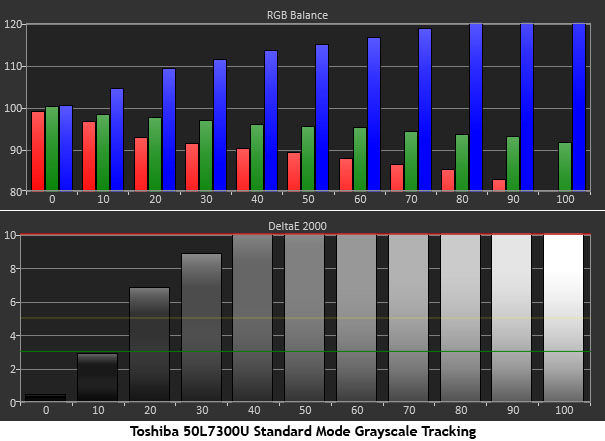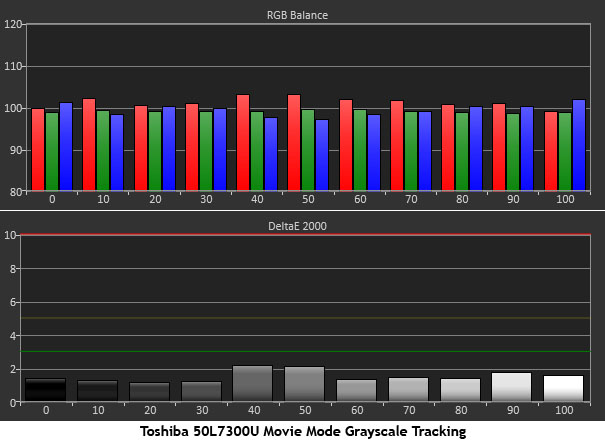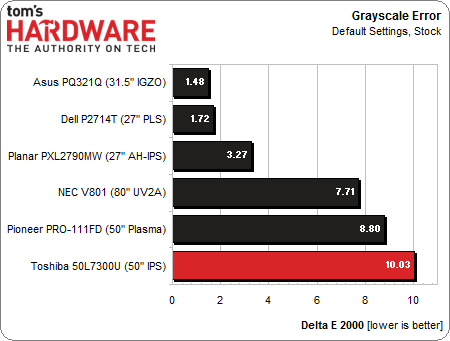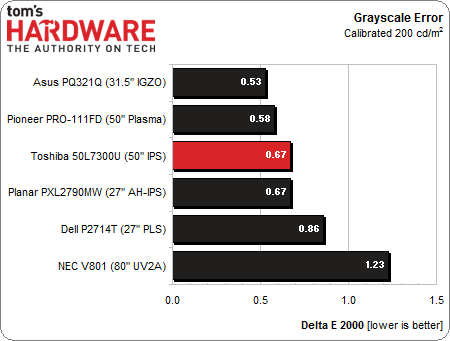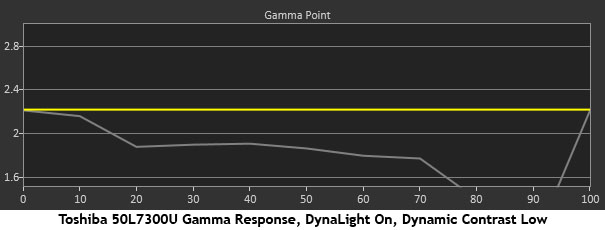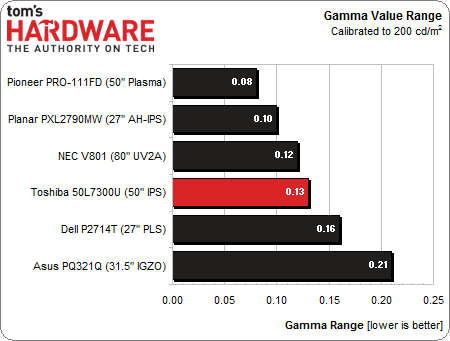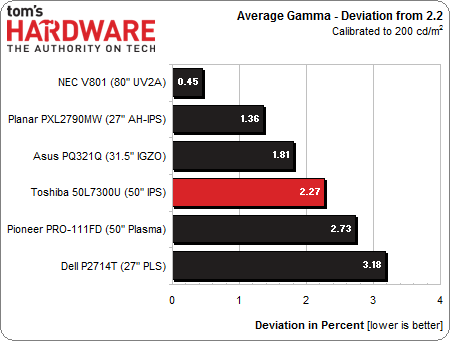Toshiba 50L7300U Review: A 50-Inch LED HDTV With Wi-Fi
You've seen us dramatically increase our display coverage over the last year, and now we're reviewing HDTVs too. Our first screen is Toshiba’s 50-inch L7300U Cloud TV with Wi-Fi. We run it through our lab and usability tests to see how it measures up.
Results: Grayscale Tracking And Gamma Response
The majority of monitors and HDTVs, especially newer models, display excellent grayscale tracking (even at stock settings). It’s important that the color of white be consistently neutral at all light levels from darkest to brightest. Grayscale performance impacts color accuracy with regard to the secondary colors: cyan, magenta, and yellow. Since computer monitors typically have no color or tint adjustment, accurate grayscale is key.
First up is the result from the 50L7300U’s Standard mode.
Believe it or not, this is the warm color temp preset. You can see that it’s far too blue. Errors range from 3 to 14 Delta E. That might work to help the set stand out in a store display, but it’s not what you’d want to watch at home.
Fortunately, relief is close at hand.
All we did was switch to the Movie mode and voila: an excellent result for an HDTV at this price point. None of the errors are visible. Only the 40 and 50 percent brightness points measure above two Delta E.
If you’re inclined to calibrate the 50L7300U, you’ll be rewarded for your efforts.
We're treated to another fantastic chart that shows almost perfect grayscale tracking. It's astounding that this is a $900 display; not long ago, that level of accuracy would have cost a lot more.
Get Tom's Hardware's best news and in-depth reviews, straight to your inbox.
For comparison, we’re including the NEC V801, Pioneer PRO-111FD, and the last two monitors reviewed at Tom’s Hardware.
Grayscale accuracy in the Standard mode is marginal at best. Fortunately, all that’s required to improve the outcome is switching to the Movie mode. Then, the error drops to 1.58 Delta E. While there are gains to be had from calibration, the picture is perfectly watchable without it.
Here’s what the 10-point grayscale adjustment gets you.
A .67 Delta E is one of the best results we’ve recorded for any display. Considering the price tags of the first- and second-place screens, Toshiba scores major value points. The errors after calibration range from .12 to 1.04 Delta E, and those are excellent numbers.
Gamma Response
Gamma is the measurement of luminance levels at every step in the brightness range from 0 to 100 percent. This is important because poor gamma can either crush detail at various points or wash it out, making the entire picture appear flat and dull. Correct gamma produces a more three-dimensional image, with a greater sense of depth and realism. Meanwhile, incorrect gamma can negatively affect image quality, even in monitors with high contrast ratios.
In the gamma charts below, the yellow line represents 2.2, which is the most widely accepted standard for television, film, and computer graphics production. The closer the white measurement trace comes to 2.2, the better.
Given the grayscale results above, we're not surprised by the measurement trace. There are only tiny dips at 10 and 90 percent representing luminance errors of .35 and 1.86 cd/m2. It's good that the outcome is so favorable too, since the 50L7300U’s gamma is not adjustable.
One thing we’ve stated in computer monitor reviews is that any sort of dynamic contrast feature will have a negative impact on gamma more than any other metric. To illustrate our point, check out the trace below.
This is what happens when you turn DynaLight On and set Dynamic Contrast to Low. Of course, it's only a measurement. Whether you use Dynamic Contrast is ultimately a matter of personal preference and depends greatly upon the quality of your content. There are certainly times when it's appropriate to use. Fortunately, Toshiba’s implementation doesn’t crush shadow detail at the Low setting. The only drawback is that overall light output is reduced.
Here’s our test group again for the gamma comparisons.
Gamma tracking is nice and tight with only a .13 variation. Such a small aberration is not something you’ll see in actual content.
The average value is equally accurate.
A 2.27-percent variation is also invisible to the naked eye. The maximum luminance error of 1.8 cd/m2 occurs at the 90-percent brightness level.
Current page: Results: Grayscale Tracking And Gamma Response
Prev Page Results: Brightness And Contrast Next Page Results: Color Gamut And Performance
Christian Eberle is a Contributing Editor for Tom's Hardware US. He's a veteran reviewer of A/V equipment, specializing in monitors. Christian began his obsession with tech when he built his first PC in 1991, a 286 running DOS 3.0 at a blazing 12MHz. In 2006, he undertook training from the Imaging Science Foundation in video calibration and testing and thus started a passion for precise imaging that persists to this day. He is also a professional musician with a degree from the New England Conservatory as a classical bassoonist which he used to good effect as a performer with the West Point Army Band from 1987 to 2013. He enjoys watching movies and listening to high-end audio in his custom-built home theater and can be seen riding trails near his home on a race-ready ICE VTX recumbent trike. Christian enjoys the endless summer in Florida where he lives with his wife and Chihuahua and plays with orchestras around the state.
